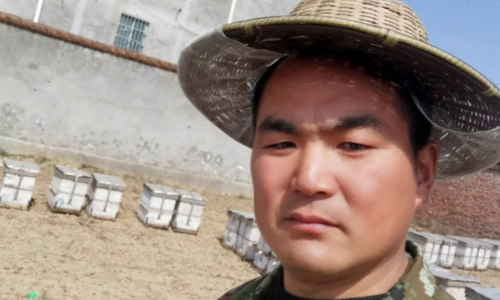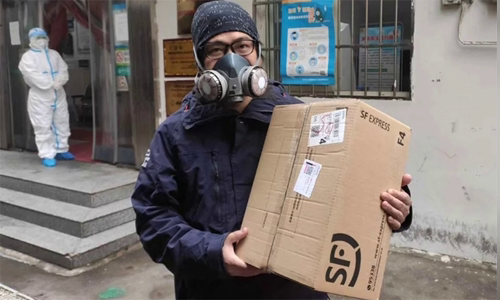Wu Haijian, a beekeeper, was finally able to return to Hubei on March 11 after nearly two months of his home blockade.
After nearly two months of blockade with strict quarantine regulations, life is gradually returning to normal in China. Covid-19, an epidemic that infected more than 80,800 people and more than 3,200 deaths in the country, is making positive changes.

Wu Haijian, a beekeeper, returned to Hubei in Yunnan province on March 11 Photo: SCMP
Frontline health workers were relieved when the number of new patients dropped sharply, and the situation of many others improved. Schools, factories, parks and attractions have reopened. In Qinghai province, northwestern China, the first of the 144 high schools and vocational schools opened today, tourist destinations in Yunnan, Sichuan and Guizhou will be welcoming guests from this week.
The relaxation of travel restrictions also allows some Hubei residents to return home after weeks of being stranded elsewhere. One of them is Wu Haijian, the driver who traveled a long way from Yunnan province to Hubei on March 11.
Every year, the 36-year-old beekeeper, who comes to Yunnan in late November to raise honey bees, returns in early March when cabbage flowers bloom in the fields of their homeland. However, this year is different when nearly 60 million people of the province were frozen in late January due to the outbreak of Covid-19.
Wu and his friends, who are also stranded in Yunnan, have been calling the local authorities to ask permission to return to Wuhan from March 1. "We call every day, so much so that they don't even pick up when we see our phone number," Wu said.
They finally received approval on March 9. Armed with a health certificate issued by Yunnan Province and a letter of approval from Hubei authorities, Wu loaded 150 beehives out that evening.
"I feel better. In the end, I was home," he said.
The blockade cost him a loss of 30,000 yuan ($ 4,300) due to one-tenth of bees infected with pesticides. Previously, he avoided this situation by returning to Hubei at the time when Yunnan farmers started spraying pesticides on rapeseed fields.
Also on March 11, Wang Faji, a migrant worker, took a bus from his home town of Guizhou to Guangzhou province. The 26-year-old construction worker has been working away from home for four years, returning home only once a year during Tet and returning to work after the full moon in January.
This year, due to the epidemic, Wang stayed home for one more month and had no income. During that time, he did two things: seeking employment information in Guangzhou as well as isolation measures in his home country, and demanding his former employer 4,800 yuan of unpaid wages from two years ago.
"The disease affects my life but is not serious. My only hope is to get a salary," he said.
Despite losing income for a month, Wang said this was "acceptable" and praised the Chinese government for swift control of Covid-19. "I am impressed with the quick response of the government," he said.
Meng Yuecui, 51, who has worked as a sanitation worker in Beijing for more than 10 years, said people working in the service industry, especially restaurant owners, have been badly affected by the disease.
Meng was fortunate to be paid by the company during the isolation in his hometown of Hebei province. She is waiting for the authorities to ease the blockade and get everyone back to work. Some of her friends who work in sanitation are less fortunate to lose their jobs during isolation weeks.

Tian Xi, a volunteer in Wuhan, said the past few days he had received fewer support requests Photo: SCMP
"In my industry, people often have to look for work," she said.
Wang and Meng are among 173 million Chinese immigrant workers from rural areas to big working cities. As more and more cities removed travel restrictions, local governments in manufacturing centers on China's east coast hired buses, trains and airplanes to return workers to work.
Last week, President Xi Jinping made his first visit to the Wuhan epidemic, a move signaling that China has almost won the epidemic. A day later, the Hubei government issued a notice asking the companies to resume operations in an orderly manner, although people were still banned from leaving the province.
Hubei is divided into regions with 3 levels of high, medium and low risk. Companies in low-risk areas may gradually resume production, while in high-risk areas, only companies involved in disease prevention, public service and supplies are allowed to reopen.
With the medical staff fighting the nCoV in Wuhan, the day they are home is approaching.
Tian Xi, 33, a volunteer with the China Foundation for Biodiversity and Green Development, came to Wuhan from the first day of the New Year, two days after the city was blockaded. He assisted organizations that distribute medical supplies to the hospital 5 times a day during the peak of the epidemic, as well as taking patients and doctors to the hospital, distributing masks to people.
He has witnessed desperate people jumping to suicide, dead patients lay for hours in the hospital without anyone taking care of them.
"The situation last week clearly went well when we received fewer offers of support," Tian said. "Now, the fight has reached the second half and I hope it ends soon."
Mary Li, a nurse in Nanjing, capital of Jiangsu province, has been sent to Wuhan for nearly a month now. She and her colleagues looked after 70 beds at Wuhan No. 1 Hospital, changing shifts every four hours.
Before entering the intensive care unit, they must wear full body wear, a hat, a mask, glasses and shoe covers. In the early days, they had trouble breathing and had masks on their faces.
However, the situation is getting better. On March 10, 32 patients were discharged from the hospital at Li, while some critically ill people no longer used ventilators and their appetite improved.
"When they left the hospital, the time we got home was closer," she said.



 EnelrahcNahilaam
EnelrahcNahilaam







